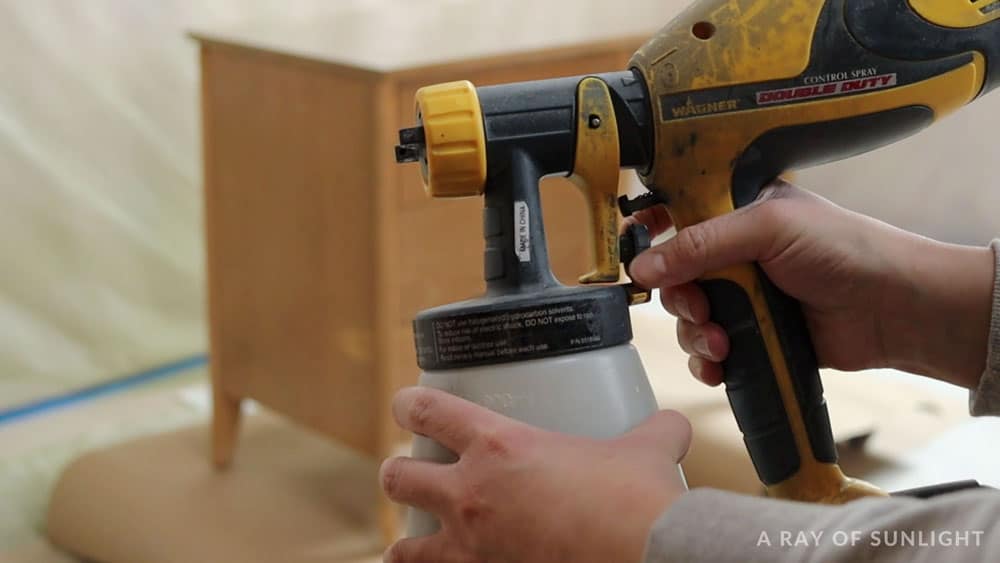Honest Wagner Double Duty Paint Sprayer Review
Looking into the Wagner Double Duty paint sprayer and wondering if it’s worth it? Will it do what you need it to do? Here’s our honest Wagner Double Duty paint sprayer review! We’ll be sharing its pros and cons, where to buy, and share more details on how to use a paint sprayer on furniture.
We understand that buying any new tool can be overwhelming, especially with all the different options available on the market. Let’s dive into this Wagner sprayer and see if it’s the right fit for you!
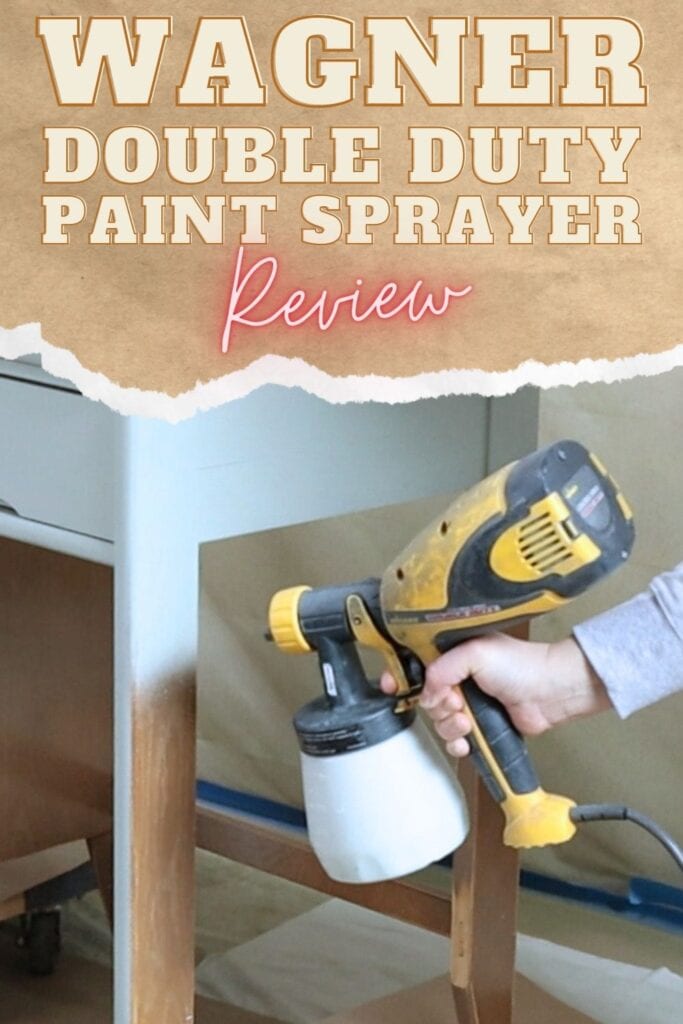
As an Amazon Associate, I earn from qualifying purchases. I also may earn from other qualifying purchases with other companies or get free product to review and use. All opinions are my own.
The Wagner Double Duty paint sprayer was the very first paint sprayer that I bought when I wanted to start spraying paint on my furniture makeovers.
Actually, no, I take that back. I bought a Critter paint sprayer first, but soon learned that my small air compressor wasn’t big enough, or strong enough to power a paint sprayer.
I didn’t want to have to buy a bigger air compressor, so that paint sprayer went back to the store. Then I was on the hunt for a paint sprayer that didn’t need an air compressor. I wanted it to be as simple as it possibly could be.
That’s when I bought the Wagner Double Duty paint sprayer. Now I’m here to give you my honest review on it.
Wagner Double Duty Paint Sprayer Review
Just like any other tool, the Wagner Double Duty paint sprayer has its pros and cons. Considering them can help you weigh your decision and determine if this is the right paint sprayer for your needs.
Pros:
- Beginner friendly
- Low cost
- No air compressor needed
- Sprays stain, polyurethane, and paint
- Comes with two containers
Cons:
- You HAVE to thin paint (BUT it comes with a viscosity cup to help you!)
- Getting a super fine finish is possible, but not always easy
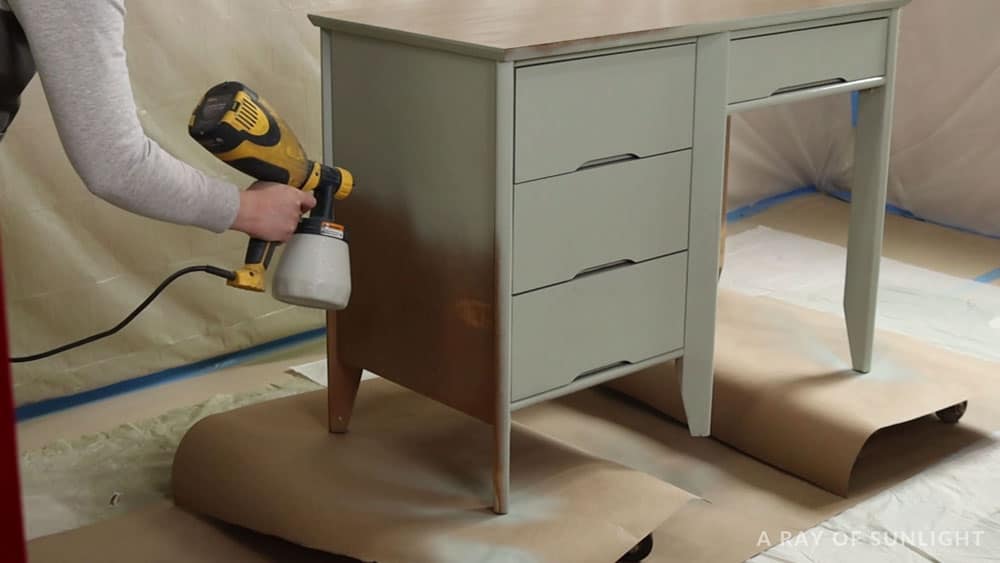
Pros of Wagner Double Duty Paint Sprayer
Let’s break all of these pros down.
Beginner Friendly
It’s honestly really simple to use. But you haven’t ever used a paint sprayer before, it might be a bit overwhelming. I completely understand. I remember when I first bought a paint sprayer, I was so nervous about messing something up, clogging it, and not thinning out the paint right.
But when you break it down, it’s really simple to use. It only has a few options for controls, so you don’t get overwhelmed with a bunch of settings.
You can:
- Adjust the spray pattern to a circle OR to a vertical or horizontal fan.
- Adjust how much paint comes out when you pull the trigger.
And you don’t need an air compressor, so you don’t have to figure out getting that hooked up as well.
BONUS TIP: If you’re really nervous to try it, try spraying some water through it at first, just to get a feel for how it works. Then you can fill it up with some paint, and test it out on some cardboard before you really dive into the project.
Low Cost
Paint sprayers can get pretty expensive! I’ve actually spent about $1500 on a professional paint sprayer system. So, spending less than $80 is a steal! Plus, you don’t have to buy an expensive air compressor for this paint sprayer.
No Air Compressor Needed
To power some paint sprayers, you need a decently big air compressor. That means that you won’t want to tote it around, making your paint sprayer stationary instead of portable.
Air compressors also take up more room. So not needing an air compressor is huge in my book! I love that I can take this paint sprayer anywhere.
Sprays Stain, Polyurethane, and Paint
Yep, you can spray wood stain, polyurethane or paint with this bad boy. You can spray oil based, shellac based, or water based products too. Basically, if your product is thicker than stain, you’ll have to thin it out. But, it’s not rocket science to thin it out!
For years I used this paint sprayer to spray thick chalk paint onto my painted furniture makeovers. And chalk paint is thick thick stuff, thicker than latex paint. If it can spray chalk paint, without compromising the quality of the paint, you’re in business! (Yes, it really can!)
Comes with Two Containers
I love that it comes with two containers. A larger one and smaller one.
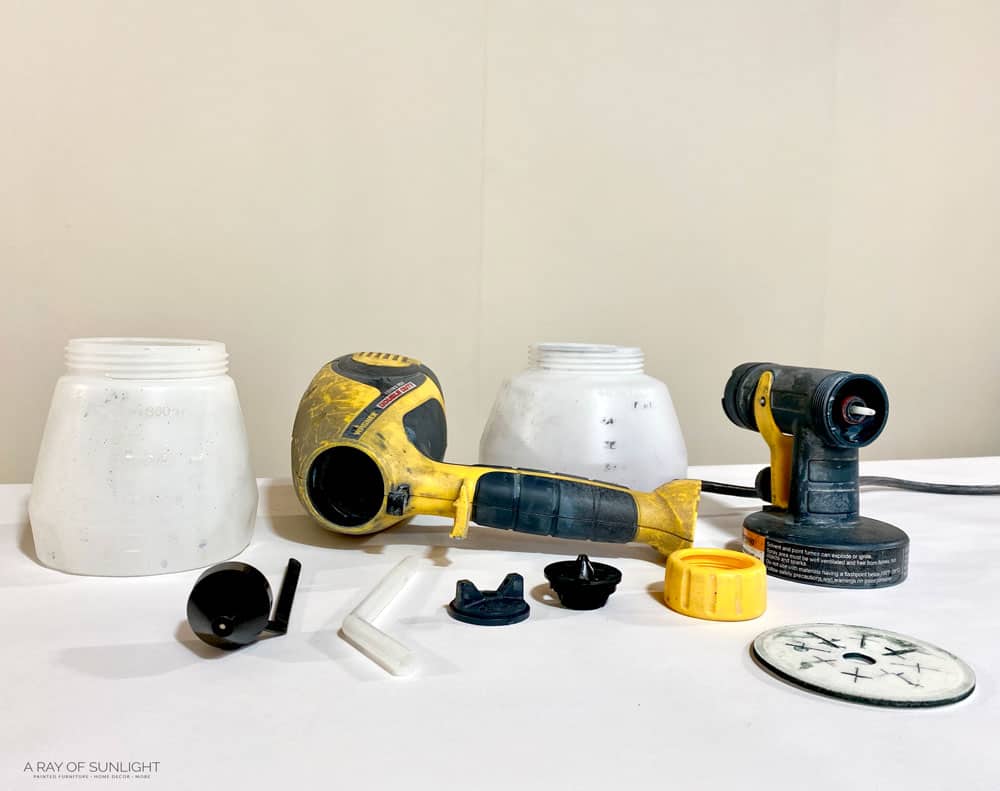
I personally use the larger container for the paint, and the smaller container for water based polyurethane. But it’s also handy to switch between the two when you have a larger project or a smaller project.
Cons of Wagner Double Duty Paint Sprayer
Now let’s break down the cons.
Have to Thin Paint
Now for the biggest con and the biggest question I had when I bought the paint sprayer. You HAVE to thin paint, or else it just won’t spray. Anything thicker than wood stain has to be thinned out.
BUT Wagner includes a viscosity cup with the paint sprayer, so you don’t have to guess how much water (or thinning agent) you need to add to your paint.
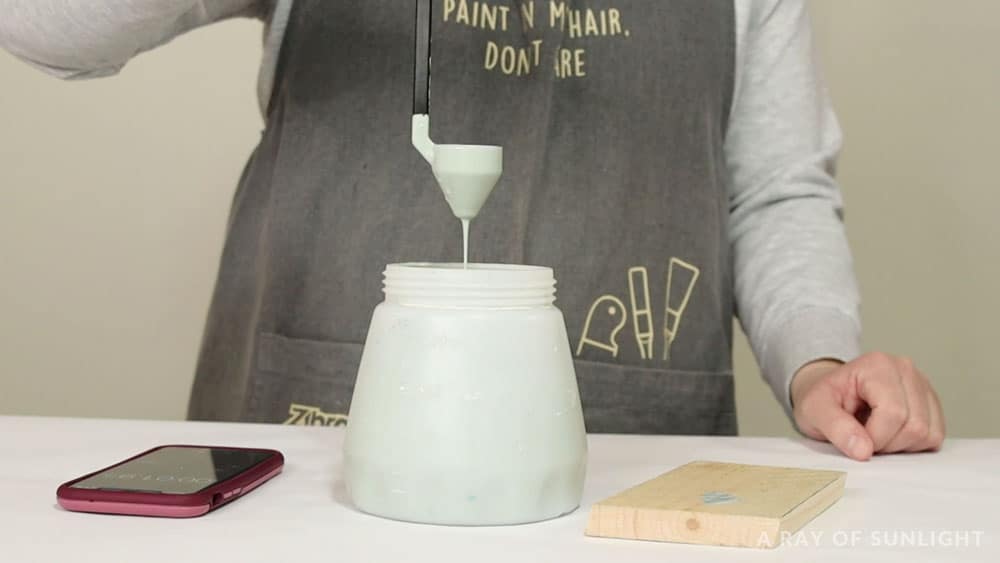
Water-based products can be thinned with water or Floetrol. (I always just use water.) Oil-based products can be thinned with paint thinner. Check out this post on how to thin the paint for a Wagner sprayer for step by step details.
But basically, the viscosity cup lets you know if the paint is thin enough (or too thin). Just fill-up the cup and let it flow out of the bottom of the cup. You want the cup to empty out in a certain amount of time. And then you’ll know that it’s the right thickness for your paint sprayer.
Also, a lot of beginner-friendly paint sprayers require thinning. So unless you want to pay a lot more for a paint sprayer, get ready to thin the paint. (But I’ve found that a lot of other sprayers don’t include the viscosity cup!)
Getting a Super Fine Finish is Possible, But Not Always Easy to Do
I don’t know if this is a super fair “con,” but I think it’s something that should definitely be mentioned. When I first bought this paint sprayer, I was so happy to not have brush marks, and that painting went so much faster than brushing it on.
I wasn’t super picky about having a really fine finish on my furniture. Sometimes it would be absolutely amazing, and other times it would be a little bit more rough.
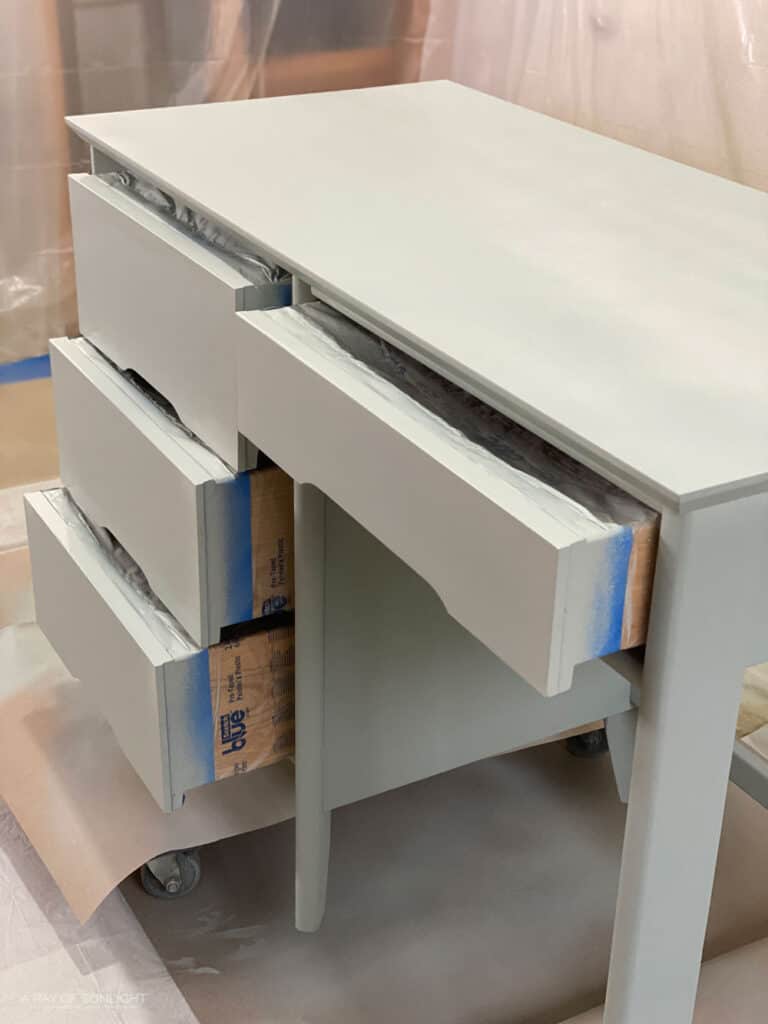
But it was a huge upgrade from brushing the paint on. But, over time I got pickier and pickier about the finish that I wanted. And I would spend a lot of time making sure the paint and settings were just right so there weren’t any little bumps in my finish.
That’s when I looked into a professional paint sprayer instead. I ended up buying this Fuji Q4 paint sprayer so I could have a really fine finish on my painted projects. It definitely comes with a price tag though!
For me, it was worth upgrading to a professional paint sprayer, because I do this all the time. But, if I was just doing a project here and there, it never would have been worth it to me to buy a fancy professional paint sprayer.
There are also many other more budget friendly options like this HomeRight Super Finish Max paint sprayer that you can get a very nice finish with too! Check out my paint sprayer reviews here to learn more about other paint sprayers.
(Update: The HomeRight might be an even easier way to get a smooth finish than the Double Duty.)
You can get a really nice professional-looking finish with the Wagner Double Duty paint sprayer. BUT, it may take some extra tweaking when you thin the paint or messing with the settings more to get it just right.
Is the Wagner Double Duty Paint Sprayer Worth It?
Short and concise, is it worth it to buy the Wagner Double Duty Paint Sprayer? Well that’s going to very, depending on what you’re looking for.
For a beginner, YES. For portability, YES. For a super professional fine finish, maybe. Maybe not. In my personal opinion, it’s a good starter paint sprayer. You can get a feel for if you like spraying or not.
**Update: I’m not sure that it’s the sprayer I would first recommend to beginners anymore though. Check out my post on the best HVLP paint sprayers for furniture for some other options and comparisons. Here’s my post for the best electric paint sprayer to help you out.
You don’t have to break the bank on anything super expensive if you want a professional fine finish, but you might spend some extra time tweaking the paint and settings to get it just right. (Remember to test it out on cardboard before spraying your project!)
I hope this review helped make your decision a little bit easier!
How to clean Wagner Double Duty Paint Sprayer?
Cleaning your Wagner Double Duty paint sprayer is definitely important! First, you’ll want to make sure that you clean it immediately after each use. This will help prevent the paint from drying on the sprayer and clogging it up.
Start by unplugging the sprayer and emptying any leftover paint back into its original container. Then, use a cleaning solution to rinse out the sprayer’s container and suction tube.
Next, fill the container with more cleaning solution and plug the sprayer back in, spraying it for about 20 seconds to make sure there is no leftover product inside.
Once you’ve sprayed out all of the cleaning solution, it’s time to disassemble the sprayer and give each piece a thorough cleaning with a brush or rag. Make sure to clean inside the nozzle and head of the sprayer as well.
After everything is clean, let it all dry before reassembling and storing for future use. Here’s our complete guide on how to clean a Wagner paint sprayer you can check out for more tips and tricks.
By keeping your Wagner Double Duty paint sprayer clean, you’ll guarantee that it continues to perform at its best every time!
More Paint Sprayer Resources
- How to Clean a Wagner Paint Sprayer
- How to Spray Polyurethane
- How to Spray Paint a Dresser with Chalk Paint
- Best Wagner Paint Sprayers for Furniture
- Wagner vs HomeRight Paint Sprayers
Follow us on YouTube to get more tips for painting furniture.
Or share your project with us on our Facebook Group and be part of our community. See you there!




